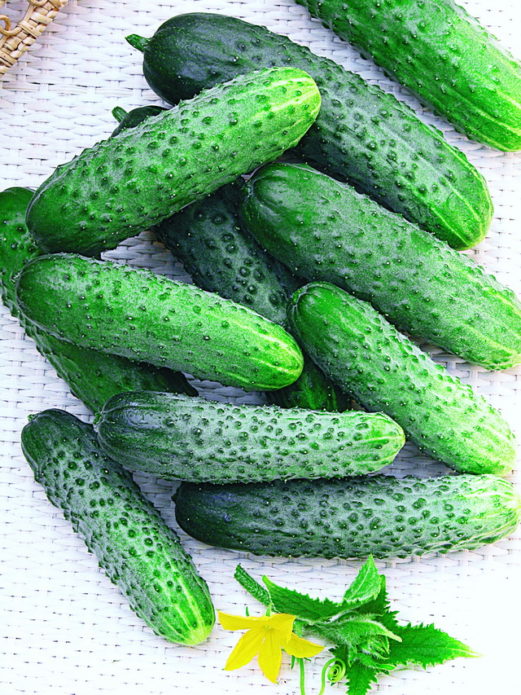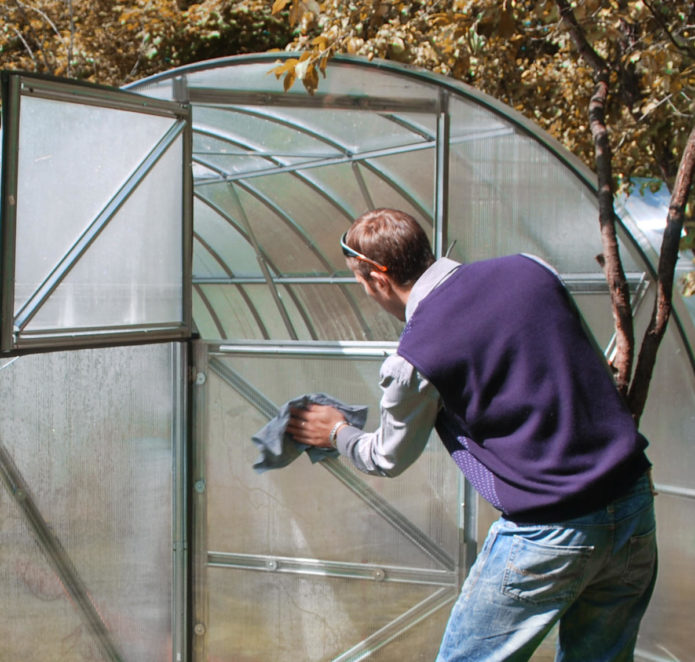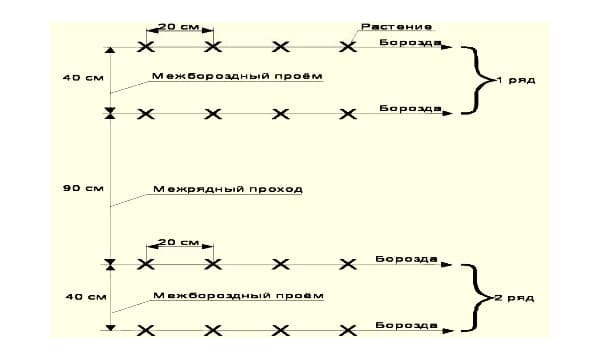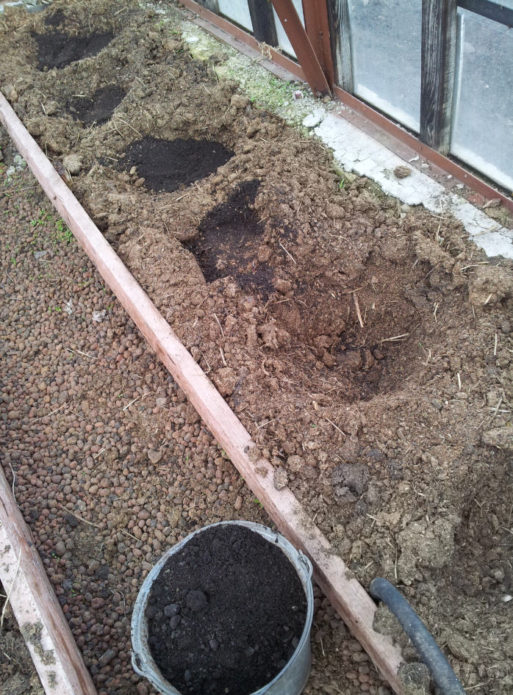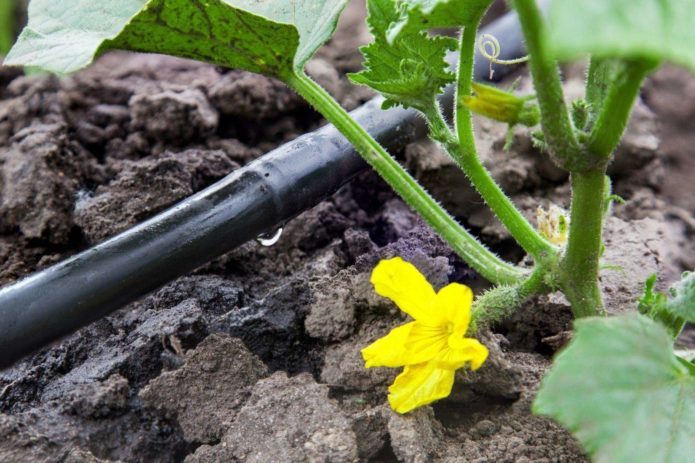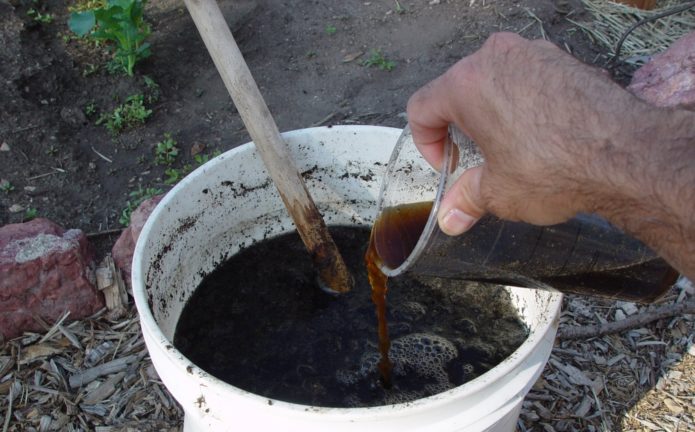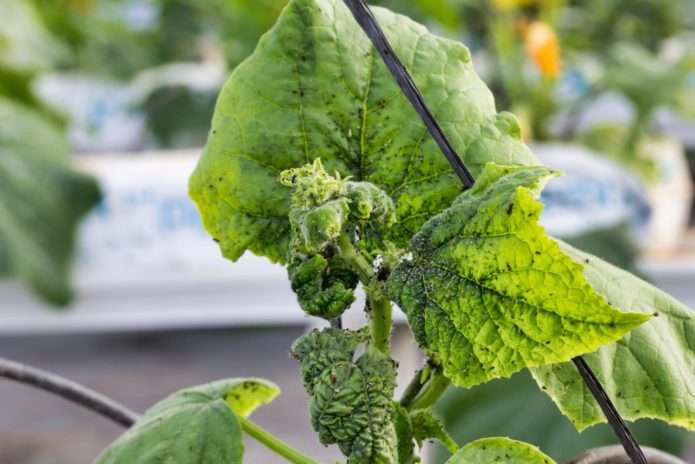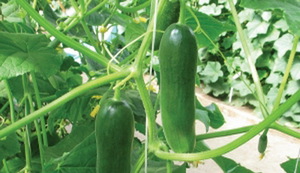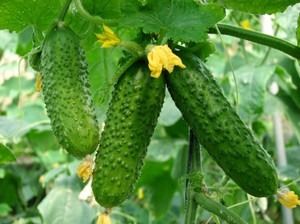Polycarbonate greenhouses are not just a tribute to fashion: they really made a small revolution in gardening. They are reliable, durable, but when using them, one must also remember that an almost sealed structure requires systematic ventilation. Nevertheless, in the cultivation of many vegetables and, in particular, cucumbers in unfavorable climatic conditions, these greenhouses provide invaluable assistance.
Content
Basic requirements for growing cucumbers
Polycarbonate greenhouses are widely used because cucumbers need:
- strict adherence to humidity and temperature conditions: during the day 23-27 aboutC, slightly colder at night, air humidity 70–80%, soil - about 60%;
- normal lighting with a day length of at least 10-12 hours, preferably diffused so that ultraviolet light does not burn the plants;
- nutritious soil, with the possibility of its annual renewal in order to destroy pathogens and pests.
It is in such greenhouses that light, passing through cellular materials, is properly scattered, almost without losing intensity, heat does not escape through the cracks, which are practically absent, and some types of greenhouses are portable, and they can be rearranged to a new place without shoveling the soil and complete replacing it inside the greenhouse.
What varieties of cucumbers are best for planting in a greenhouse
Currently, there are many varieties and hybrids of cucumbers. Many of them are specially introduced for greenhouses. As a rule, they are shade-tolerant (after all, part of the solar radiation is absorbed by the walls of the greenhouse), they are able to withstand high temperatures (after all, the owner does not always have time to ventilate the greenhouse in time) and self-pollinated (not every greenhouse is visited by bees in the right amount).
It is the self-pollinated cucumbers (parthenocarpic) that should be chosen for greenhouses in the first place. At the same time, if it is possible to attract bees to the greenhouse with the help of, for example, sugar syrup, or the gardener himself is ready to pollinate flowers in manual mode, you can plant bee-pollinated varieties.
In addition to the method of pollination, it is worth focusing on the purpose of the variety: they can be salad, pickled (for canning) and universal. According to the ripening period, early cucumbers (fruiting in 40–45 days after sowing the seeds), mid-ripening (45–50) and late ones are distinguished. It is necessary to pay attention to both disease resistance and yield.
In recent years, the following varieties have been planted more often than others in greenhouses:
- Emelya (early maturing, vigorous, high-yielding, with sweetish fruits up to 20 cm long);
- Courage (early maturing, disease resistant, unpretentious, with fruits up to 15 cm long, well stored);
- Masha (ultra-early ripe, undersized, with small tasty fruits);
- Mazai (early maturing, with fruits up to 17 cm long, very tasty, but requiring high-quality care);
- Marinda (early maturing, unpretentious variety, high-yielding, with medium-sized fruits, disease-resistant);
- Herman (early ripe representative of bunch varieties, fruits are ideal for canning, without bitterness).
Gardeners do not forget about old, well-deserved cucumbers, for example, Zozulya, which bears very large fruits, which is distinguished by its reliability, guaranteed obtaining a high yield.
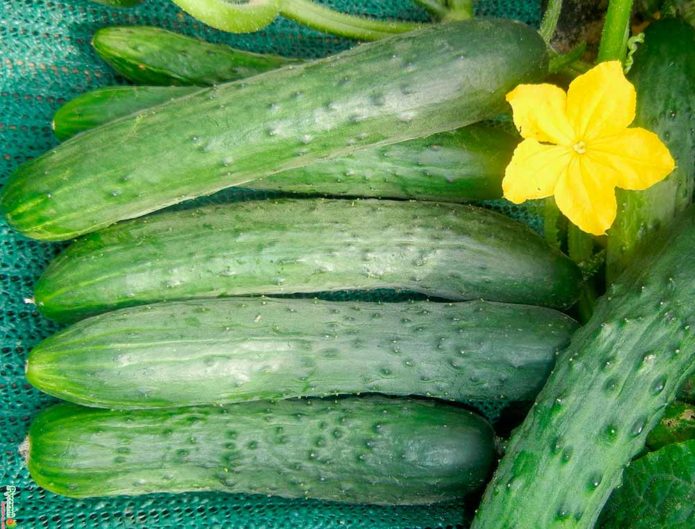
Zozulya's cucumber - a representative of long-fruited varieties - is very good, but outwardly not as cute as many of its brothers
The timing of planting cucumbers in the greenhouse
Most often, polycarbonate greenhouses are used in an unheated mode, therefore, the timing of planting cucumbers in them depends primarily on the climate of the region. So, planting cucumber seedlings in a greenhouse in the Moscow region or a region similar in climate is possible closer to mid-May. In the North-West region or in Siberia - by the end of spring. When sowing seeds directly into the greenhouse - a week earlier. Of course, if you have heating, you can plant cucumbers in February (depending on the quality of the greenhouse).
It is difficult to specifically determine the timing of landing, you should be guided by the current weather. The temperature in the greenhouse during the day, which allows planting seedlings, should not be lower than 16-18 aboutC, and at night - do not fall below 10 aboutFROM. The soil should also be warmed up. Based on these figures, the timing of the start of home growing of seedlings is roughly determined: they are planted in a greenhouse at the age of 25-30 days, and even a week is needed for the emergence of seedlings when sown with dry seeds.
Greenhouse preparation
Before planting seedlings (or sowing seeds), the greenhouse must be prepared. First of all, all surfaces are washed with ordinary soap, after which the greenhouse is ventilated. Then the walls and supporting structures should be disinfected with a 1% solution of ferrous sulfate, having previously scraped off possible growths mechanically. If the trellis is reusable, disinfect it well. If cucumbers are grown by tying them to stakes, the stakes are driven into the soil already when digging the beds, having previously walked with a disinfectant solution and over them.
It is much more important to process the soil. If diseases raged last year, it should be replaced with a fresh one. This is hard physical work, since you will have to remove a layer of soil 20–25 cm high. If there were no particular difficulties with diseases, the soil after digging is spilled with a 1% solution of copper sulfate. Often enough treatment with a solution of lime (500 g per bucket of water), which is not only watered, but also treated with a brush, the greenhouse stands and the equipment used.
In recent years, many people prefer Fitosporin solution (20 ml of the drug per bucket of water).
Since it is difficult to process all the places with a sprayer and a brush, some gardeners use a sulfur stick to disinfect the greenhouse. Fumigation is carried out in a warm time and should be at least 3 hours.
Cucumbers require large amounts of fertilizers, especially organic ones. They normally tolerate even fresh manure, which is contraindicated in most vegetable crops. But semi-matured manure, and even more humus, is easier to digest, therefore, when preparing the beds, they try to use humus, and if it is not there, peat-compost mixtures. 1 m2 make from one and a half buckets of organic matter, adding to it up to 100 g of azophoska or a good handful of wood ash.
Planting scheme for cucumbers in the greenhouse
Cucumbers can be grown in various ways, the most common are:
- an ordinary method (planting in one row with a distance between rows up to a meter (in greenhouses - at least 70 cm), plants are planted in a row every 15–30 cm;
- tape (two-line) method (two rows are located 30-50 cm apart, and between such strips, if there are many, leave at least a meter): planting density - as in the ordinary method;
- square-nesting method (cucumbers are planted in "nests" located 60–70 cm apart, often staggered): up to 5 plants are grown in each nest.
In greenhouse conditions, tape planting is most popular if it is convenient to place the bed directly opposite the entrance to the greenhouse. If the greenhouse is small, use a single row planting near the wall. If a lot of cucumbers are grown, using the entire area of the greenhouse for them, the choice of the scheme depends on the desire of the gardener. If only a few plants are planted, planting in buckets, bags or barrels is also possible.
Landing technique
Planting seedlings is simple. It is important to water the seedlings in pots well in the morning.
- After leveling the beds with a rake, in the places designated according to the chosen scheme, small holes are made with a depth slightly more than the height of the pots.
- A small handful of ash and a tablespoon of azofoska are added to the wells, mixed well with the ground, poured over with warm water.
- Peat pots with seedlings are planted in holes with a slight deepening (maximum - cotyledonous leaves). If the pots are reusable, it is important to remove the seedlings from them without damaging the roots; it is planted with a clod of earth in the same way.
- Water well with warm water, mulch with peat or humus.
Sowing seeds directly into the greenhouse is carried out according to the same schemes as planting ready-made seedlings, only a little earlier. To do this, make grooves with any convenient tool according to the selected scheme, water them from a watering can without a strainer and then lay out the cucumber seeds at the required distances. If there is no deficiency in seeds, you can sow thicker, and then remove the weakest plants. The seeds are covered with soil or humus with a layer of about 3 cm.You can cover the bed with a film before the shoots appear, but remove it in time.
Care of cucumber seedlings after planting in a greenhouse
Growing a good harvest of cucumbers is not easy even in a polycarbonate greenhouse: care is needed all the time. After all, if the summer resident can visit the cucumbers planted in unprotected soil only on weekends, then in the greenhouse without periodic airing they will simply suffocate, and it is not possible to open the doors and leave in any weather.
Watering
The soil under the cucumbers should be moderately moist at all times, but waterlogging is unacceptable: the roots must breathe. Mulching with a layer of humus of 3-4 cm greatly facilitates the observance of the humidity regime, but watering in the greenhouse is often required: after all, it does not rain. Many gardeners equip drip irrigation systems, this saves water and energy, ensures uniform soil wetting, but periodically arrange sprinkling for cucumbers in the greenhouse. True, after such a procedure, airing is necessary so that the leaves do not remain wet for a long time.
Watering is possible only with water heated in the sun or in some other way: the optimum temperature is 25-30 aboutFROM. Cold water often makes cucumbers sick. Watering at the very root is dangerous, since this can cause exposure of the roots; if this happens, the plants are carefully huddled, adding soil from the side.
If the bushes have not yet closed, shallow loosening is carried out soon after watering (in the presence of mulching material, loosening is carried out very rarely, with its renewal). Weeds must be destroyed immediately: they not only drain the soil, but also attract pests.
The frequency of watering is also related to the observance of the temperature regime: in the heat, large leaves of cucumbers intensively evaporate water. In a polycarbonate greenhouse, it is easy to maintain a microclimate with the required air humidity, but you can easily overheat the air. Therefore, airing is necessary, but it is impossible to arrange drafts: either only the doors or the upper vents are opened.
Top dressing
Cucumbers are often fed in the greenhouse, at least five times over the summer. The main top dressing for cucumber is a variety of organic infusions: based on mullein, bird droppings or cut grasses... In an extreme case, they take complex mineral fertilizers, but they must add top dressing in a dissolved form, after watering. On poor soils, mullein infusion (200 g per bucket of water), fermented for 2-3 days, can be enriched with superphosphate (30 g).
The very first top dressing (7-10 days after planting the seedlings) can be done with a urea solution, then - with organic matter - cucumbers are fed every 2 weeks. Periodically sprinkle the soil around the plants with wood ash.
A couple of times during fruiting, you can carry out foliar dressing by spraying the leaves with a solution of 2 g of boric acid in 10 liters of water.
For full-fledged fruiting, cucumbers need not only food in the soil, but also carbon dioxide in the air. Therefore, they try to keep that mullein or dung that is prepared for feeding directly in the greenhouse; here they also put fertilizer solutions for fermentation.
Disease prevention, pest control
With proper agricultural technology, modern varieties and hybrids of cucumbers rarely get sick, and pests do not often get into the greenhouse. But you have to be on your guard. Diseases, especially fungal infections, are most likely to develop in poorly ventilated greenhouses... More often than others there are powdery mildew, fusarium, various rot. Prevention is maintaining the correct temperature and humidity conditions, timely removal of excess shoots and leaves.
Powdery mildew is usually treated with folk remedies: by spraying with a highly diluted infusion of mullein or half-diluted sour milk... In most cases, copper-containing preparations are well saved from fungal diseases. For preventive purposes, shortly before flowering, cucumbers can be treated with 1% Bordeaux liquid.
To restore the immunity of fruiting plants, foliar feeding with 1% urea solution helps, which also helps in the fight against certain diseases.
Of the pests, cucumbers in greenhouses are most often visited by melon aphids and spider mites. And if it is possible to fight against aphids with folk remedies (infusions of ash, tobacco dust, tansy, etc.), only in extreme cases resorting to chemical insecticides, then with ticks it is more difficult. Ticks are killed only by acaricides, and most of them are very dangerous for humans. Spraying is possible only before the entry of cucumbers into fruiting... True, with a small number of ticks, good old Karbofos can help, but he is not a gift, so it is better not to allow the tick into the greenhouse: remove weeds in time, and periodically spray the plantings with infusion of hot pepper (50 g per 10 l of water), which scares this pest.
Features of the formation of a cucumber when grown in a greenhouse
In greenhouses, every centimeter is expensive, so cucumbers are grown in vertical culture, tying lashes to trellises or high stakes. The first garter may be required as early as a week after transplanting. For a garter, use any soft twine, the loops do not tighten tightly. It is possible to guide the main stem around one vertically stretched twine or periodically tie it up in several places: it all depends on the design of the supporting structure.
It is imperative to form cucumbers in a greenhouse: this is a redistribution of their forces from the formation of a leaf mass to an increase in yield. When cutting off excess fragments, the illumination of the plants, as well as their ventilation, improves. The technology of pinching and pruning depends more on the variety of cucumber, but for most parthenocarpic hybrids it is the same.
We used to know that when the 5th or 6th leaf appears, the main stem is pinched, and this causes additional branching of the bush. Most modern self-pollinating varieties, on the contrary, lead to one stem, greatly shortening the lateral shoots. Pinching begins when the plant reaches a height of about 30 cm, using sharp scissors:
- If by this moment something else has appeared up to the 5-6th leaf (lateral shoots, buds), they are broken out, organizing a “blinding zone”.
- Above, up to a height of 1 meter, only one ovary and one leaf above it are left on each lateral shoot.
- At a height of 1 m to 1.5 m, the lateral shoots are given the opportunity to form 2 ovaries, and above - 3-4, pinching the shoots above the corresponding leaf.
- When the main shoot reaches the top of the trellis, it can be pinched or thrown over the crossbar and allowed to grow downward.
Often, cucumbers themselves grab onto obstacles, but from time to time they need help by directing the shoots in the desired direction and tying them up.
Video: caring for greenhouse cucumbers
Growing good cucumbers is not easy. Greenhouses help this in colder climates, but require more frequent and skilled gardener intervention in the process. You can't leave greenhouse cucumbers unattended even for several days.
